Production of Tetraploid Plants from Cotyledons of Diploid Melia volkensii Gürke
Abstract
:1. Introduction
2. Materials and Methods
2.1. Plant Material and Initiation
2.2. Chromosome Counting
2.3. Polyploidization
2.4. Ploidy Determination
2.5. In Vitro Propagation of the Tetraploid Melia volkensii Plants
2.6. Morphological Characteristics of the Tetraploid Melia volkensii in Comparison of Diploids
2.7. Statistical Analysis of Data
3. Results
3.1. Chromosome Counting
3.2. Induction of Tetraploidy
3.3. Morphological Characteristics of In Vitro Tetraploid Melia volkensii
3.4. Leaf and Stomatal Morphology of Tetraploid and Diploid Melia volkensii under Greenhouse Conditions
4. Discussion
5. Conclusions
Author Contributions
Funding
Data Availability Statement
Acknowledgments
Conflicts of Interest
References
- Assis, T.F.; de Resende, M.D.V. Genetic Improvement of Forest Tree Species. Crop Breed. Appl. Biotechnol. 2011, 11, 44–49. [Google Scholar] [CrossRef]
- Tsujii, Y.; Sakai, S.; Ushio, M.; Aiba, S.; Kitayama, K. Variations in the Reproductive Cycle of Bornean montane Tree Species along Elevational Gradients on Ultrabasic and Non-Ultrabasic Soils. Biotropica 2022, 55, 210–220. [Google Scholar] [CrossRef]
- Orwa, C.; Mutua, A.; Kindt, R.; Jamnadass, R.; Simons, A. Agroforestree Database: A Tree Reference and Selection Guide Version 4.0: Melia Volkensii; World Agroforestry Centre: Nairobi, Kenya, 2009. [Google Scholar]
- Johnson, L.P.V. The Breeding of Forest Trees. For. Chron. 1939, 15, 139–151. [Google Scholar] [CrossRef]
- Silva, A.J.; Carvalho, C.R.; Clarindo, W.R. Chromosome Set Doubling and Ploidy Stability in Synthetic Auto- and Allotetraploid of Eucalyptus: From in Vitro Condition to the Field. Plant Cell. Tissue Organ Cult. 2019, 138, 387–394. [Google Scholar] [CrossRef]
- Kuang, Y.; Lu, C.H.; Hsu, F.C. Restoring Fertility for Novel Interspecific Hybrids between Kalanchoe garambiensis and K. Nyikae Using Colchicine Treatment. Plants 2021, 10, 209. [Google Scholar] [CrossRef] [PubMed]
- Wang, Z.; Fan, G.; Dong, Y.; Zhai, X.; Deng, M.; Zhao, Z.; Liu, W.; Cao, Y. Implications of Polyploidy Events on the Phenotype, Microstructure, and Proteome of Paulownia australis . PLoS ONE 2017, 12, e0172633. [Google Scholar] [CrossRef]
- Saleh, B.; Allario, T.; Dambier, D.; Ollitrault, P.; Morillon, R. Tetraploid Citrus Rootstocks Are More Tolerant to Salt Stress than Diploid. Comptes Rendus Biol. 2008, 331, 703–710. [Google Scholar] [CrossRef]
- Li, M.; Zhang, C.; Hou, L.; Yang, W.; Liu, S.; Pang, X.; Li, Y. Multiple Responses Contribute to the Enhanced Drought Tolerance of the Autotetraploid Ziziphus jujuba Mill. Var. Spinosa. Cell Biosci. 2021, 11, 119. [Google Scholar] [CrossRef]
- Abdolinejad, R.; Shekafandeh, A.; Jowkar, A. In Vitro Tetraploidy Induction Creates Enhancements in Morphological, Physiological and Phytochemical Characteristics in the Fig Tree (Ficus carica L.). Plant Physiol. Biochem. 2021, 166, 191–202. [Google Scholar] [CrossRef]
- Fetouh, M.I.; Kareem, A.; Knox, G.W.; Wilson, S.B.; Deng, Z. Induction, Identification, and Characterization of Tetraploids in Japanese Privet (Ligustrum Japonicum). HortScience 2016, 51, 1371–1377. [Google Scholar] [CrossRef]
- Ewald, D.; Ulrich, K.; Naujoks, G.; Schröder, M.B. Induction of Tetraploid Poplar and Black Locust Plants Using Colchicine: Chloroplast Number as an Early Marker for Selecting Polyploids in Vitro. Plant Cell Tissue Organ Cult. 2009, 99, 353–357. [Google Scholar] [CrossRef]
- Castillo, A.; López, V.; Tavares, E.; Santiñaque, F.; Dalla Rizza, M. Polyploid Induction of Eucalyptus dunnii Maiden to Generate Variability in Breeding Programs. Agrociencia Urug. 2020, 24, 381. [Google Scholar] [CrossRef]
- Lu, M.; Zhang, P.; Wang, J.; Kang, X.; Wu, J.; Wang, X.; Chen, Y. Induction of Tetraploidy Using High Temperature Exposure during the First Zygote Division in Populus denopoda Maxim. Plant Growth Regul. 2014, 72, 279–287. [Google Scholar] [CrossRef]
- Wu, J.; Sang, Y.; Zhou, Q.; Zhang, P. Colchicine in Vitro Tetraploid Induction of Populus hopeiensis from Leaf Blades. Plant Cell Tissue Organ Cult. 2020, 141, 339–349. [Google Scholar] [CrossRef]
- Liu, W.; Song, S.; Li, D.; Lu, X.; Liu, J.; Zhang, J.; Wang, J. Isolation of Diploid and Tetraploid Cytotypes from Mixoploids Based on Adventitious Bud Regeneration in Populus . Plant Cell Tissue Organ Cult. 2020, 140, 1–10. [Google Scholar] [CrossRef]
- Yan, X.; Zhang, J.; Zhang, H. Induction and Characterization of Tetraploids in Poplar. Plant Cell Tissue Organ Cult. 2021, 146, 185–189. [Google Scholar] [CrossRef]
- Liu, Z.; Wang, J.; Qiu, B.; Ma, Z.; Lu, T.; Kang, X.; Yang, J. Induction and Characterization of Tetraploid Through Zygotic Chromosome Doubling in Eucalyptus urophylla . Front. Plant Sci. 2022, 13, 870698. [Google Scholar] [CrossRef]
- Jambhale, N.D.; Patil, S.C.; Pawar, S.V. Induction of Polyploidy in Pride-of-India (Melia azedarach Linn), an Agroforestry Tree. Indian J. Genet. Plant Breed. 2002, 62, 245–247. [Google Scholar]
- Barceló-Anguiano, M.; Holbrook, N.M.; Hormaza, J.I.; Losada, J.M. Changes in Ploidy Affect Vascular Allometry and Hydraulic Function in Mangifera indica Trees. Plant J. 2021, 108, 541–554. [Google Scholar] [CrossRef]
- De Storme, N.; Geelen, D. Sexual Polyploidization in Plants—Cytological Mechanisms and Molecular Regulation. New Phytol. 2013, 198, 670–684. [Google Scholar] [CrossRef]
- Shi, Q.H.; Liu, P.; Liu, M.J.; Wang, J.R.; Xu, J. A Novel Method for Rapid in Vivo Induction of Homogeneous Polyploids via Calluses in a Woody Fruit Tree (Ziziphus jujuba Mill.). Plant Cell Tissue Organ Cult. 2015, 121, 423–433. [Google Scholar] [CrossRef]
- Eeckhaut, T.G.R.; Werbrouck, S.P.O.; Leus, L.W.H.; Van Bockstaele, E.J.; Debergh, P.C. Chemically Induced Polyploidization in Spathiphyllum wallisii Regel through Somatic Embryogenesis. Plant Cell Tissue Organ Cult. 2004, 78, 241–246. [Google Scholar] [CrossRef]
- Dhooghe, E.; Grunewald, W.; Leus, L.; Van Labeke, M.C. In Vitro Polyploidisation of Helleborus Species. Euphytica 2009, 165, 89–95. [Google Scholar] [CrossRef]
- Correia, J.J. Effects of Antimitotic Agents on Tubulin-Nucleotide Interactions. Pharmacol. Ther. 1991, 52, 127–147. [Google Scholar] [CrossRef]
- Dhooghe, E.; Denis, S.; Eeckhaut, T.; Reheul, D.; Van Labeke, M.C. In Vitro Induction of Tetraploids in Ornamental Ranunculus . Euphytica 2009, 168, 33–40. [Google Scholar] [CrossRef]
- Eng, W.H.; Ho, W.S. Polyploidization Using Colchicine in Horticultural Plants: A Review. Sci. Hortic. 2019, 246, 604–617. [Google Scholar] [CrossRef]
- Hias, N.; Leus, L.; Davey, M.W.; Vanderzande, S.; Van Huylenbroeck, J.; Keulemans, J. Effect of Polyploidization on Morphology in Two Apple (Malus × Domestica) Genotypes. Hortic. Sci. 2017, 44, 55–63. [Google Scholar] [CrossRef]
- Denaeghel, H.E.R.; Van Laere, K.; Leus, L.; Lootens, P.; Van Huylenbroeck, J.; Van Labeke, M.C. The Variable Effect of Polyploidization on the Phenotype in Escallonia . Front. Plant Sci. 2018, 9, 354. [Google Scholar] [CrossRef]
- Mori, S.; Yahata, M.; Kuwahara, A.; Shirono, Y.; Ueno, Y.; Hatanaka, M.; Honda, Y.; Sugiyama, K.; Murata, N.; Okamoto, Y.; et al. Morphological Characterization of Tetraploids of Limonium sinuatum (L.) Mill. Produced by Oryzalin Treatment of Seeds. Horticulturae 2021, 7, 248. [Google Scholar] [CrossRef]
- Bouvier, L.; Guérif, P.; Djulbic, M.; Durel, C.E.; Chevreau, E.; Lespinasse, Y. Chromosome Doubling of Pear Haploid Plants and Homozygosity Assessment Using Isozyme and Microsatellite Markers. Euphytica 2002, 123, 255–262. [Google Scholar] [CrossRef]
- Contreras, R.N. A Simple Chromosome Doubling Technique Is Effective for Three Species of Cupressaceae. HortScience 2012, 47, 712–714. [Google Scholar] [CrossRef]
- Diallo, A.M.; Nielsen, L.R.; Kjær, E.D.; Petersen, K.K.; Ræbild, A. Polyploidy Can Confer Superiority to West African Acacia senegal (L.) Willd. Trees. Front. Plant Sci. 2016, 7, 821. [Google Scholar] [CrossRef] [PubMed]
- Le, S.; Griffin, R.A.; Harwood, C.E.; Vaillancourt, R.E.; Harbard, J.L.; Price, A.; Nghiem, C.Q.; Koutoulis, A.; Nguyen, K.D. Breeding Polyploid Varieties of Acacia: Reproductive and Early Growth Characteristics of the Allotetraploid Hybrid (Acacia mangium × A. auriculiformis) in Comparison with Diploid Progenitors. Forests 2021, 12, 778. [Google Scholar] [CrossRef]
- Griffin, A.R.; Twayi, H.; Braunstein, R.; Downes, G.M.; Son, D.H.; Harwood, C.E. A Comparison of Fibre and Pulp Properties of Diploid and Tetraploid Acacia mangium Grown in Vietnam. Appita Technol. Innov. Manuf. Environ. 2014, 67, 43–49. [Google Scholar]
- Liu, C.; Liu, G.; Fang, G.; Jiang, C.; Jiang, J. Comparison of Tetraploid Betula platyphylla Wood Fiber Traits and Selection of Superior Seed Trees. J. Beijing For. Univ. 2017, 39, 9–15. [Google Scholar]
- Longui, E.L.; Custódio, G.H.; Amorim, E.P.; da Silva Júnior, F.G.; Oda, S.; Souza, I.C.G. Differences in Wood Properties among Eucalyptus grandis and Eucalyptus grandis x Eucalyptus urophylla with Different Degrees of Ploidy. Res. Soc. Dev. 2021, 10, e395101624035. [Google Scholar] [CrossRef]
- Mulanda, E.S.; Adero, M.O.; Wepukhulu, D.K.; Amugune, N.O.; Akunda, E.; Kinyamario, J.I. Thidiazuron-Induced Somatic Embryogenesis and Shoot Regeneration in Cotyledon Explants of Melia volkensii Gürke. Propag. Ornam. Plants 2014, 14, 40–46. [Google Scholar]
- Murashige, T.; Skoog, F. A Revised Medium for Rapid Growth and Bio Assays with Tobacco Tissue Cultures. Physiol. Plant. 1962, 15, 473–479. [Google Scholar] [CrossRef]
- Akbarzadeh, M.; Van Laere, K.; Leus, L.; De Riek, J.; Van Huylenbroeck, J.; Werbrouck, S.P.O.; Dhooghe, E. Can Knowledge of Genetic Distances, Genome Sizes and Chromosome Numbers Support Breeding Programs in Hardy Geraniums? Genes 2021, 12, 730. [Google Scholar] [CrossRef]
- Kirov, I.; Divashuk, M.; Van Laere, K.; Soloviev, A.; Khrustaleva, L. An Easy “SteamDrop” Method for High Quality Plant Chromosome Preparation. Mol. Cytogenet. 2014, 7, 21. [Google Scholar] [CrossRef]
- Dushimimana, C.; Magomere, T.; Mulatya, J.; Vandenabeele, J.; Olubayo, F.; Smagghe, G.; Werbrouck, S.P.O. Variation of Morphological Traits and Quality Indices of Micropropagated Melia volkensii Gürke Clones before Field Planting. Forests 2022, 13, 337. [Google Scholar] [CrossRef]
- Fetter, K.C.; Eberhardt, S.; Barclay, R.S.; Wing, S.; Keller, S.R. StomataCounter: A Neural Network for Automatic Stomata Identification and Counting. New Phytol. 2019, 223, 1671–1681. [Google Scholar] [CrossRef] [PubMed]
- Li, M.; Ding, B.; Huang, W.; Pan, J.; Ding, Z.; Jiang, F. Induction and Characterization of Tetraploids from Seeds of Bletilla striata (Thunb.) Reichb.F. Biomed Res. Int. 2018, 2018, 3246398. [Google Scholar] [CrossRef] [PubMed]
- Khosla, P.K.; Styles, B.T. Karyological Studies and Chromosome Evolution in Meliaceae. Silvae Genet. 1975, 24, 73–83. [Google Scholar]
- Datta, P.C.; Samanta, P. Cytotaxonomy of Meliaceae. Cytologia 1977, 42, 197–208. [Google Scholar] [CrossRef]
- Jha, T.B. Somatic Chromosomes of Aegle marmelos and Azadirachta indica through EMA Method. Nucleus 2014, 57, 185–188. [Google Scholar] [CrossRef]
- Mo, L.; Chen, J.-H.; Chen, F.; Xu, Q.-W.; Tong, Z.-K.; Huang, H.-H.; Dong, R.-H.; Lou, X.-Z.; Lin, E.-P. Induction and Characterization of Polyploids from Seeds of Rhododendron fortunei Lindl. J. Integr. Agric. 2020, 19, 2016–2026. [Google Scholar] [CrossRef]
- Bouvier, L.; Fillon, F.R.; Lespinasse, Y. Oryzalin as an Efficient Agent for Chromosome Doubling of Haploid Apple Shoots in Vitro. Plant Breed. 1994, 113, 343–346. [Google Scholar] [CrossRef]
- Miguel, T.P.; Leonhardt, K.W. In Vitro Polyploid Induction of Orchids Using Oryzalin. Sci. Hortic. 2011, 130, 314–319. [Google Scholar] [CrossRef]
- Mundhara, R.; Rashid, A. Stimulation of Shoot-Bud Regeneration on Hypocotyl of Linum Seedlings, on a Transient Withdrawal of Calcium: Effect of Calcium, Cytokinin and Thidiazuron. Plant Sci. 2002, 162, 211–214. [Google Scholar] [CrossRef]
- Mundhara, R.; Rashid, A. TDZ-Induced Triple-Response and Shoot Formation on Intact Seedlings of Linum, Putative Role of Ethylene in Regeneration. Plant Sci. 2006, 170, 185–190. [Google Scholar] [CrossRef]
- Mulwa, R.M.S.; Bhalla, P.L. In Vitro Plant Regeneration from Immature Cotyledon Explants of Macadamia (Macadamia tetraphylla L. Johnson). Plant Cell Rep. 2006, 25, 1281–1286. [Google Scholar] [CrossRef] [PubMed]
- Xu, L.; Najeeb, U.; Naeem, M.S.; Daud, M.K.; Cao, J.S.; Gong, H.J.; Shen, W.Q.; Zhou, W.J. Induction of Tetraploidy in Juncus effusus by Colchicine. Biol. Plant. 2010, 54, 659–663. [Google Scholar] [CrossRef]
- Gantait, S.; Mandal, N.; Bhattacharyya, S.; Das, P.K. Induction and Identification of Tetraploids Using in Vitro Colchicine Treatment of Gerbera jamesonii Bolus Cv. Sciella. Plant Cell Tissue Organ Cult. 2011, 106, 485–493. [Google Scholar] [CrossRef]
- Tang, Z.Q.; Chen, D.L.; Song, Z.J.; He, Y.C.; Cai, D.T. In Vitro Induction and Identification of Tetraploid Plants of Paulownia tomentosa . Plant Cell Tissue Organ Cult. 2010, 102, 213–220. [Google Scholar] [CrossRef]
- Tokumoto, Y.; Kajiura, H.; Takeno, S.; Harada, Y.; Suzuki, N.; Hosaka, T.; Gyokusen, K.; Nakazawa, Y. Induction of Tetraploid Hardy Rubber Tree, Eucommia ulmoides, and Phenotypic Differences from Diploid. Plant Biotechnol. 2016, 33, 51–57. [Google Scholar] [CrossRef]
- Wójcik, D.; Marat, M.; Marasek-Ciołakowska, A.; Klamkowski, K.; Buler, Z.; Podwyszyńska, M.; Tomczyk, P.P.; Wójcik, K.; Treder, W.; Filipczak, J. Apple Autotetraploids—Phenotypic Characterisation and Response to Drought Stress. Agronomy 2022, 12, 161. [Google Scholar] [CrossRef]
- Zhang, Y.; Sheng, Y.B.; Luo, X.F. Effects of Water Stress on Biomass and Photosynthetic Characteristics of Tetraploid Black Locust (Robinia pseudoacacia L.) Clones. For. Res. 2010, 23, 920–923. [Google Scholar]
- Abdolinejad, R.; Shekafandeh, A. Tetraploidy Confers Superior in Vitro Water-Stress Tolerance to the Fig Tree (Ficus carica) by Reinforcing Hormonal, Physiological, and Biochemical Defensive Systems. Front. Plant Sci. 2022, 12, 796215. [Google Scholar] [CrossRef]
- Da Silva Souza, T.; Daolio, M.F.; Mori, F.A.; Ramalho, M.A.P.; Mingossi, F.B.; Missiaggia, A.A.; Techio, V.H. Polyploidy as a Strategy to Improve the Industrial Quality of Eucalypt Wood. Wood Sci. Technol. 2021, 55, 181–193. [Google Scholar] [CrossRef]
- Navrátilová, B.; Ondřej, V.; Vrchotová, N.; Tříska, J.; Horník, Š.; Pavela, R. Impact of Artificial Polyploidization in Ajuga reptans on Content of Selected Biologically Active Glycosides and Phytoecdysone. Horticulturae 2022, 8, 581. [Google Scholar] [CrossRef]
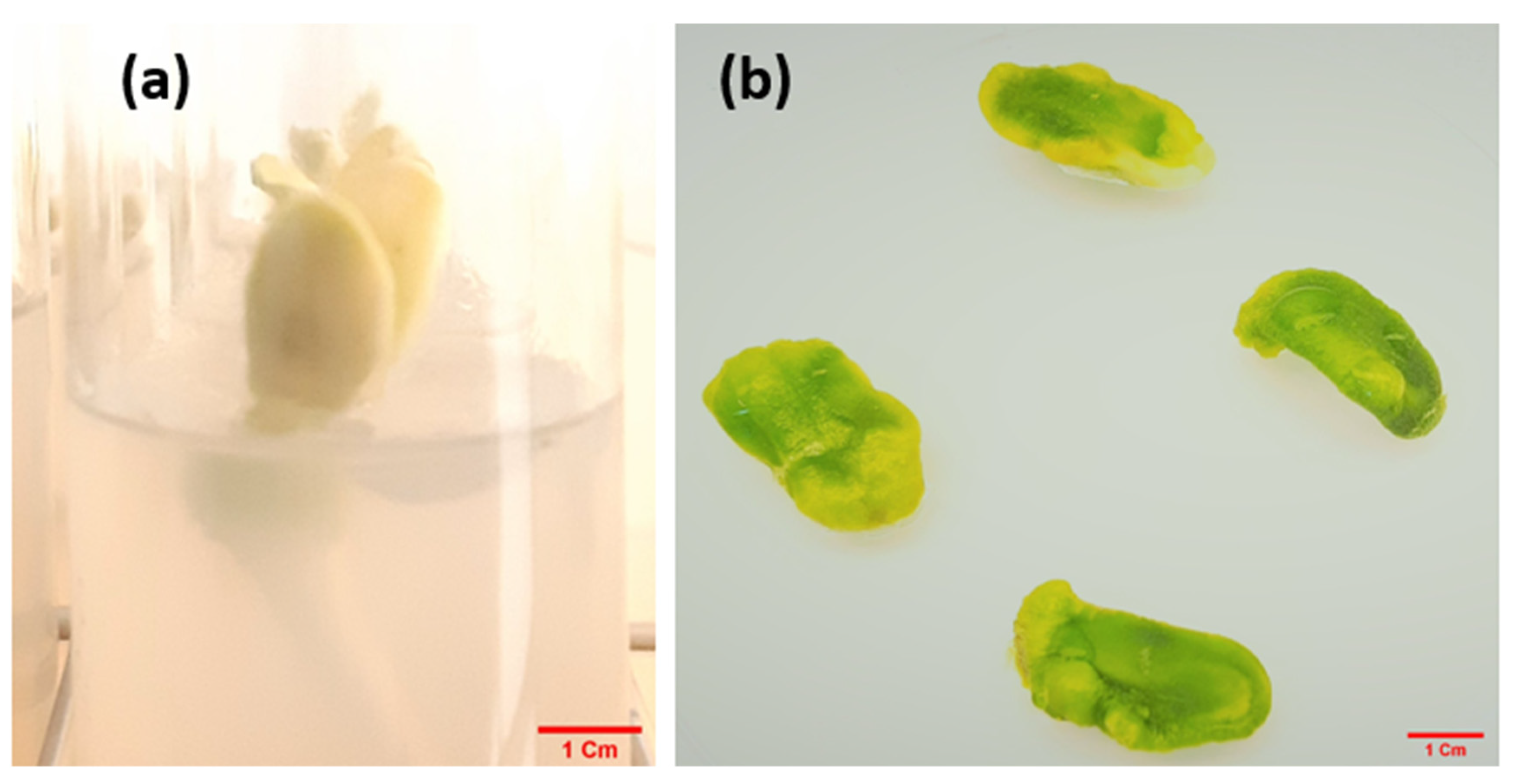
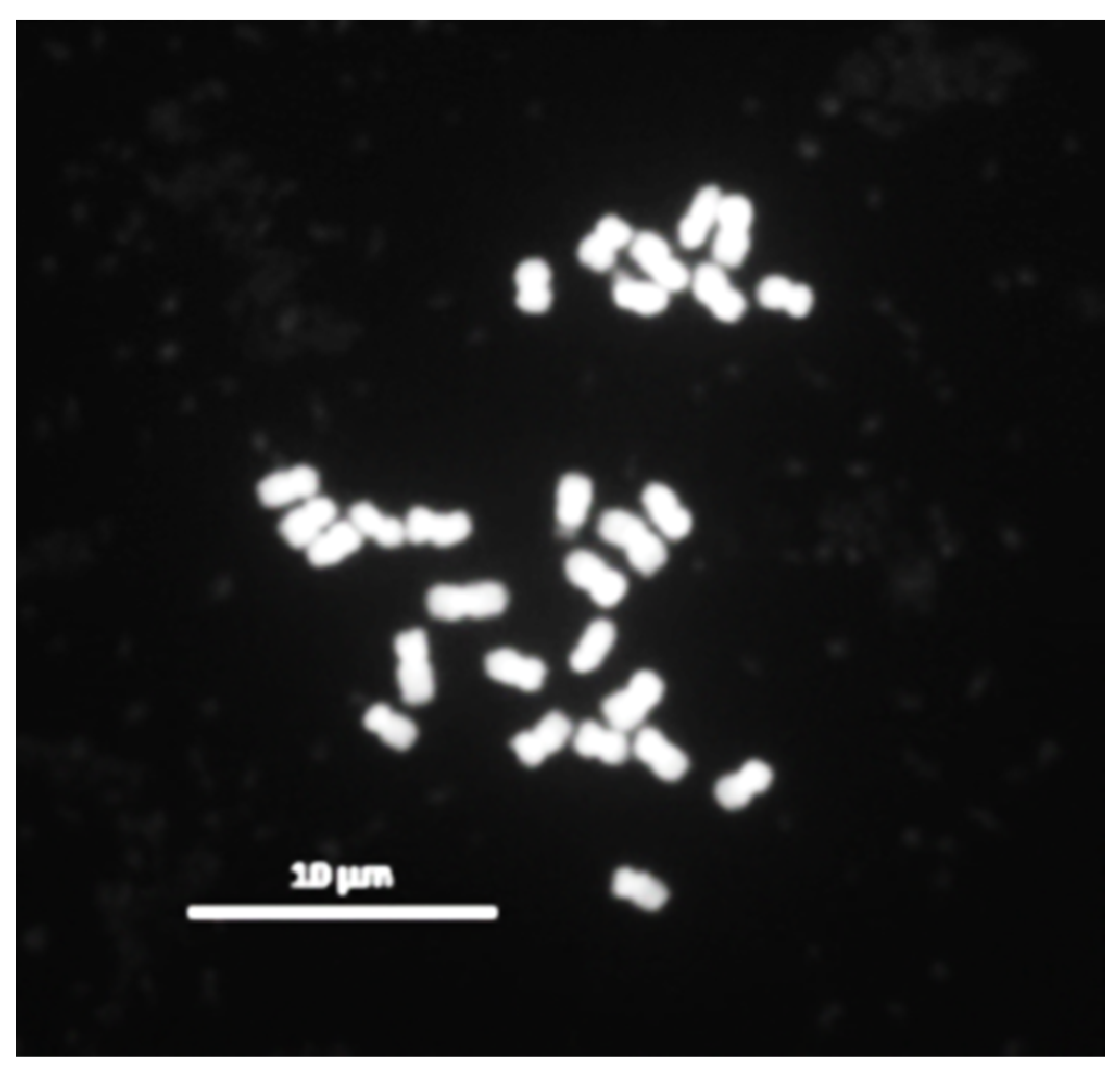
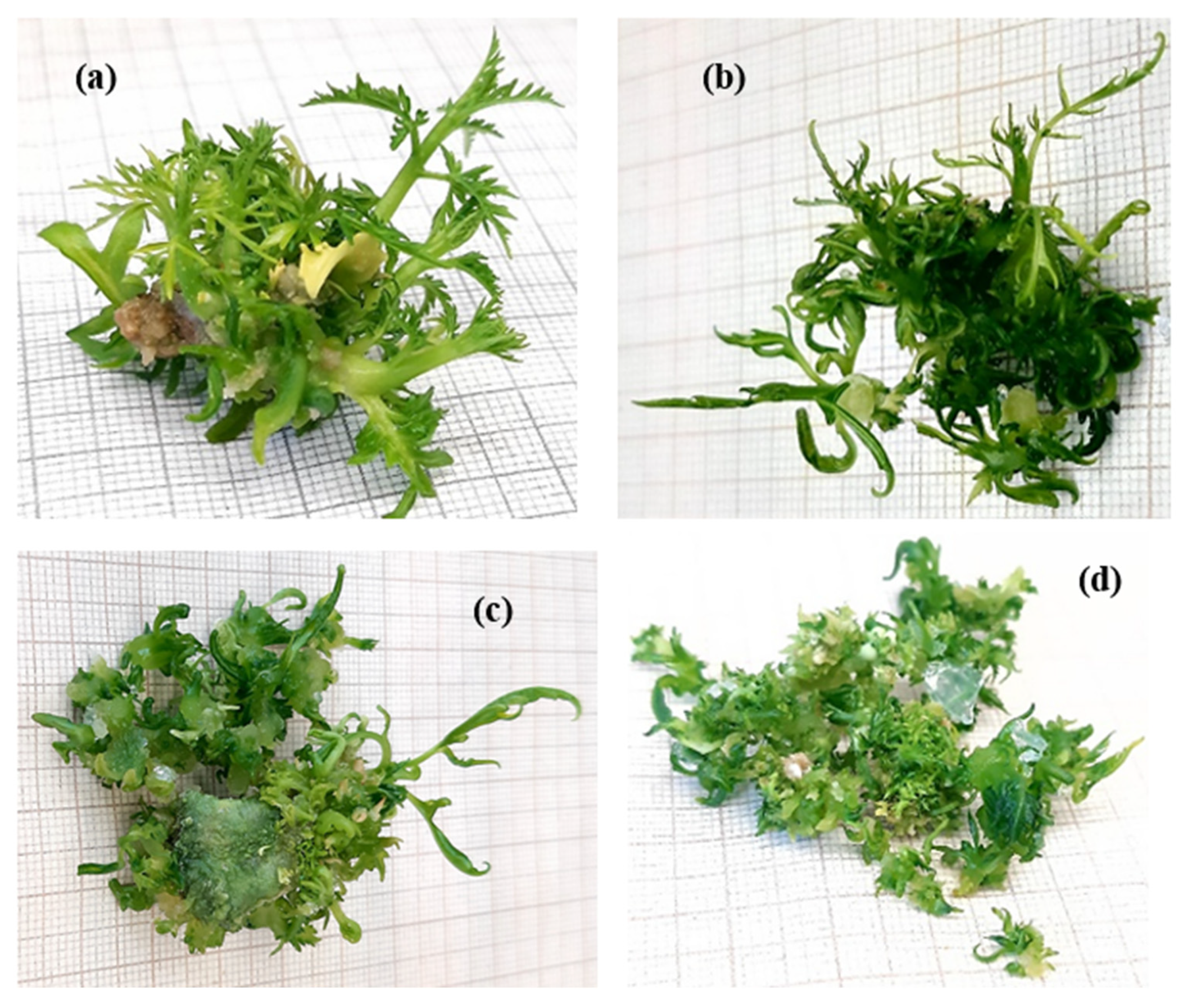



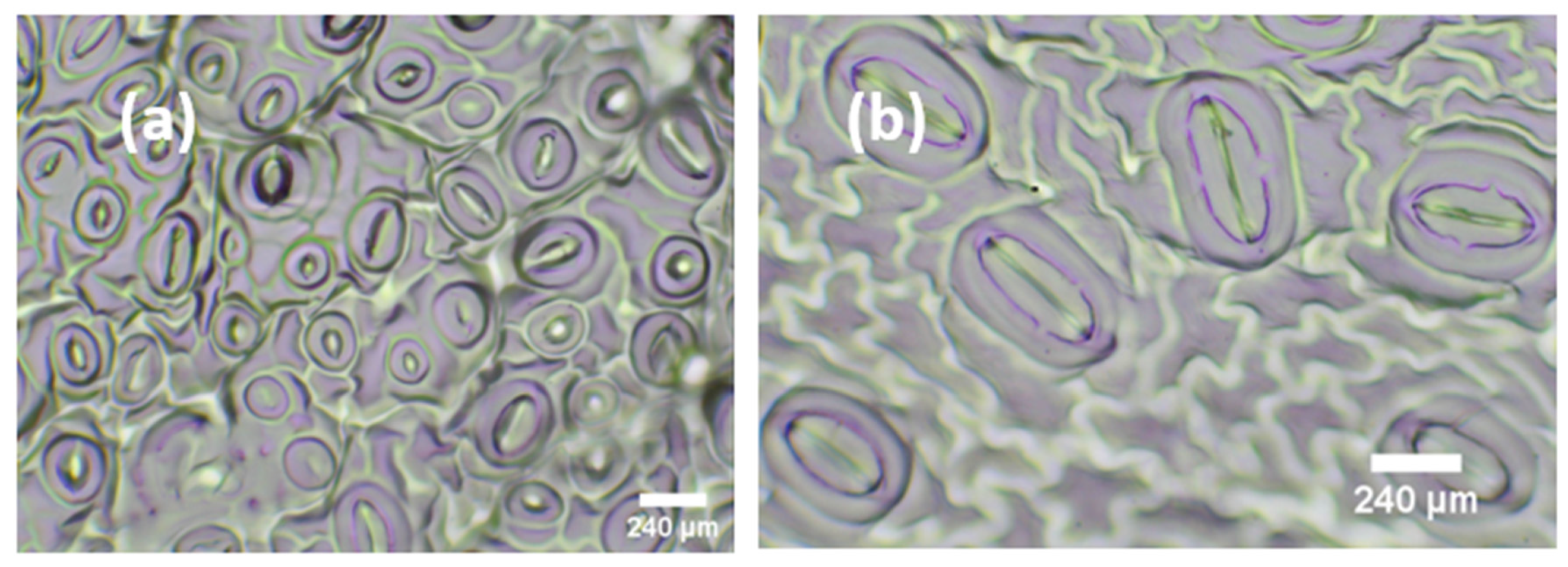
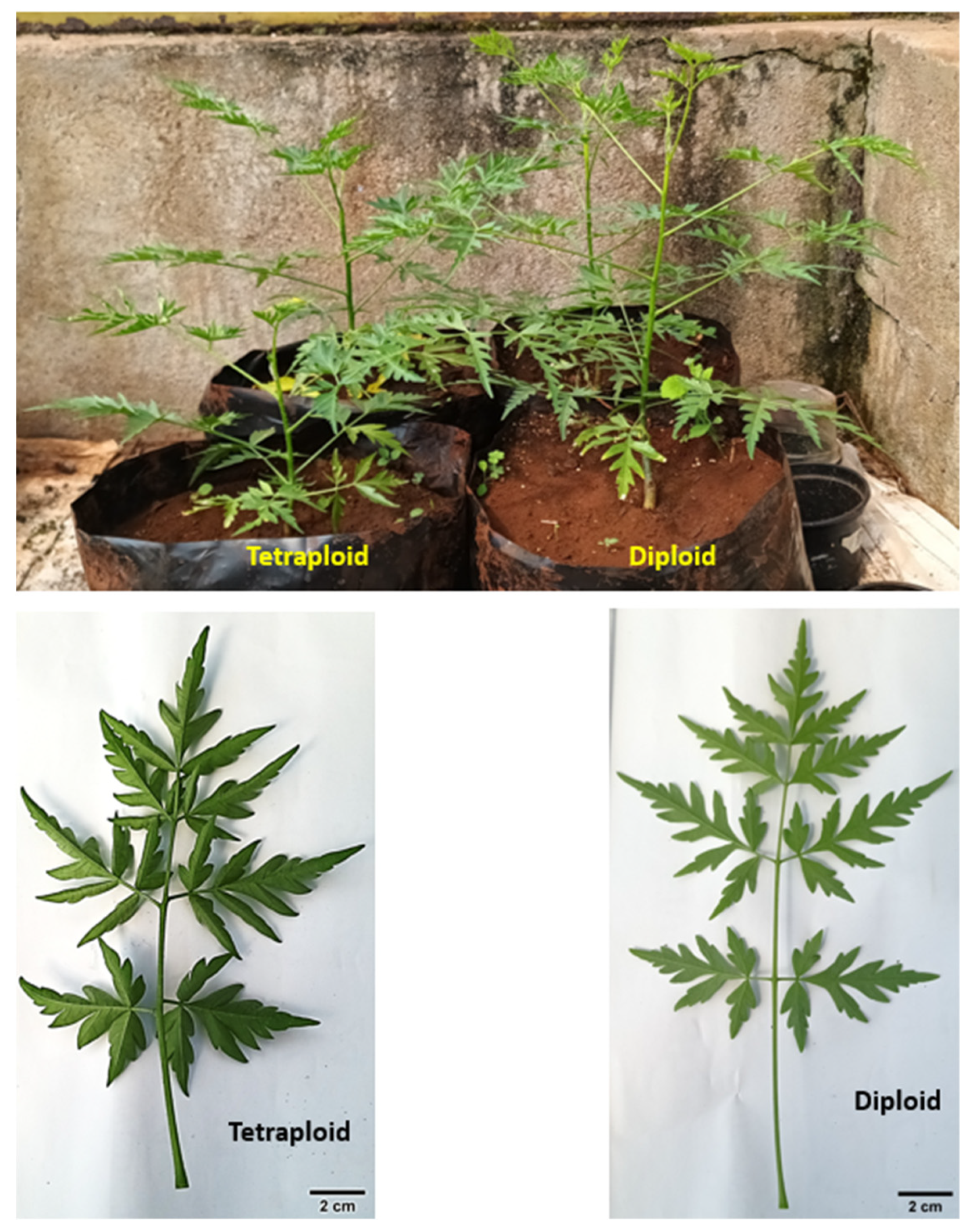
| TDZ Concentration * | Oryzalin Treatment (Hours) Duration | Analyzedplants | Tetraploid Percentage (%) | Mixoploid Percentage (%) |
|---|---|---|---|---|
| 0 | 20 | 0.0 | 0.0 | |
| 1 | 40 | 12.5 | 0.0 | |
| 0 µM | 2 | 40 | 2.5 | 0.0 |
| 3 | 40 | 40.0 | 4.8 | |
| 1 | 40 | 32.5 | 20.0 | |
| 1.1 µM | 2 | 40 | 40.0 | 5.0 |
| 3 | 40 | 52.5 | 20.0 |
| Genotypes | Number of Shoots | Shoot Length (cm) | Shoot Diameter (mm) | Number of Leaves Per Shoot | Number of Leaflets Per Leaflet | Shoot Internode Length (mm) |
|---|---|---|---|---|---|---|
| Diploid | 4.73 ± 0.30 | 4.41 ± 0.27 b | 2.36 ± 0.08 a | 7.60 ± 0.27 c | 7.67 ± 0.25 | 5.4153 ± 0.24 |
| T192-1 | 4.73 ± 0.33 | 3.37 ± 0.19 a | 3.14 ± 0.11 b | 5.80 ± 0.30 b | 7.27 ± 0.27 | 4.8360 ± 0.23 |
| T482-2 | 5.07 ± 0.38 | 3.69 ± 0.16 a | 3.10 ± 0.11 b | 5.40 ± 0.21 ab | 7.60 ± 0.23 | 4.6500 ± 0.27 |
| T432-1 | 5.73 ± 0.54 | 4.33 ± 0.28 b | 3.32 ± 0.15 bc | 6.07 ± 0.25 b | 7.27 ± 0.18 | 4.2147 ± 0.43 |
| T841-1 | 5.33 ± 0.48 | 3.26 ± 0.15 a | 3.58 ± 0.19 c | 4.87 ± 0.29 a | 7.00 ± 0.28 | 4.5987 ± 0.39 |
| p-value | 0.388 | <0.001 | <0.001 | <0.001 | 0.299 | 0.129 |
| Morphological Characteristics | Diploid | Tetraploid |
|---|---|---|
| Leaf area (cm2) | 57.54 ± 4.32 | 75.74 ± 5.09 * |
| Leaf length (cm) | 22.35 ± 0.50 | 19.96 ± 0.86 * |
| Petiole length (cm) | 8.58 ± 0.27 | 6.13 ± 0.34 *** |
| Stomata length (µm) | 1024.70 ± 14.12 | 1360 ± 14.56 *** |
| Stomata Width (µm) | 735.65 ± 10.58 | 913.12 ± 10.18 *** |
| Stomata density (per unit area) | 22.80 ± 2.52 | 11.60 ± 2.25 * |
Disclaimer/Publisher’s Note: The statements, opinions and data contained in all publications are solely those of the individual author(s) and contributor(s) and not of MDPI and/or the editor(s). MDPI and/or the editor(s) disclaim responsibility for any injury to people or property resulting from any ideas, methods, instructions or products referred to in the content. |
© 2023 by the authors. Licensee MDPI, Basel, Switzerland. This article is an open access article distributed under the terms and conditions of the Creative Commons Attribution (CC BY) license (https://creativecommons.org/licenses/by/4.0/).
Share and Cite
Dushimimana, C.; Van Laere, K.; Magomere, T.; Smagghe, G.; Werbrouck, S.P.O. Production of Tetraploid Plants from Cotyledons of Diploid Melia volkensii Gürke. Horticulturae 2023, 9, 791. https://doi.org/10.3390/horticulturae9070791
Dushimimana C, Van Laere K, Magomere T, Smagghe G, Werbrouck SPO. Production of Tetraploid Plants from Cotyledons of Diploid Melia volkensii Gürke. Horticulturae. 2023; 9(7):791. https://doi.org/10.3390/horticulturae9070791
Chicago/Turabian StyleDushimimana, Constantin, Katrijn Van Laere, Titus Magomere, Guy Smagghe, and Stefaan P. O. Werbrouck. 2023. "Production of Tetraploid Plants from Cotyledons of Diploid Melia volkensii Gürke" Horticulturae 9, no. 7: 791. https://doi.org/10.3390/horticulturae9070791
APA StyleDushimimana, C., Van Laere, K., Magomere, T., Smagghe, G., & Werbrouck, S. P. O. (2023). Production of Tetraploid Plants from Cotyledons of Diploid Melia volkensii Gürke. Horticulturae, 9(7), 791. https://doi.org/10.3390/horticulturae9070791









